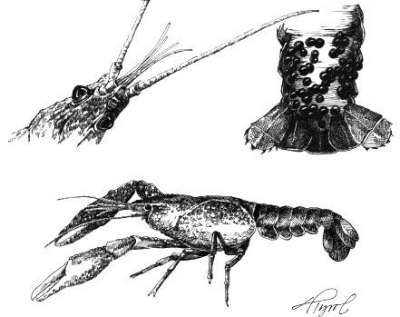
I can’t stop thinking about butter sauce. I guess that’s no surprise. When we think about crayfish, if we think about them at all, it is often as either a New Orleans-style feast or as fish bait. Not being a bass angler, when I think about crayfish, my mind wanders toward Cajun cuisine.
Maybe, though, it’s the crayfish’s resemblance to a lobster that has me thinking about butter sauce. Both lobster and crayfish are crustaceans – having a hard body-covering. Both are also decapods – having ten legs, with the first pair of legs bearing large claws. The resemblance is not superficial. On the great family tree of life, lobsters and crayfish are practically cousins.
The difference is in size and where they live. Lobsters are much larger and live in the ocean. Crayfish live in freshwater and are rarely more than a few inches long.
North America is the world’s crayfish diversity hotspot. There are about 390 species of crayfish native to this continent, which is about 75 percent of the world’s species. The red hot center of crayfish diversity is the southeastern United States, where it is not unusual to find a species of crayfish that is native to a particular river or watershed and is found nowhere else.
Having limited ranges makes these species of crayfish vulnerable to extinction. Four of them are on the federal endangered species list.
Here in Vermont and New Hampshire, the situation is different. There are just seven crayfish species in Vermont, and three or possibly four in New Hampshire (outside the Connecticut River.) James Haney, chairman of the zoology department at the University of New Hampshire, says a graduate student recently identified three crayfish species in 50 New Hampshire lakes, with one of those species found in 30 of the lakes.
In Vermont, the few crayfish species are similarly widespread. When Mark Ferguson, a zoologist with the state’s Nongame and Natural Heritage program, surveyed crayfish in the Connecticut River watershed, he was surprised to find that all seven species identified in the Lake Champlain watershed were also found across the mountains in the Connecticut.
You can call them crayfish, crawfish, crawdads, or mud bugs. It doesn’t matter. Most people don’t call the different species of crayfish by different common names, perhaps because the only sure way to tell some crayfish species apart is to closely examine the male genitalia. I’m sure I’m not alone in finding this, umm… unlikely, which means your average bass angler or butter-sauce dipper remains blissfully ignorant of the different species. That there are different species, however, and that some are native species adapted to specific locations, is incredibly important.
Of the seven species in Vermont, three of them are possibly introduced. Of those, one definite non-native is also a definite troublemaker: the rusty crayfish.
Originally from the Midwest, the rusty crayfish moves in and out-competes the natives – pushing them out of habitat and eating up more than their share of the food – with a noticeable impact on aquatic plants. Though looking at male genitalia may be the only way we can tell the species apart, the difference to other forms of life in rivers or lakes is dramatic. There is less food, or a very different type of food, available. Introduced crayfish have the ability to skew the whole aquatic ecosystem.
Ferguson found rusty crayfish in a stretch of the Connecticut River from Orford to Bellows Falls and up into the White River system. He reports finding higher concentrations of rusty crayfish at public access points along the rivers. This is no accident. While aquaculture and the live-food trade introduce crayfish to new habitats in some parts of the country, around here crayfish travel in bait buckets.
The good news from Ferguson’s survey is that the rusty crayfish is not found throughout Vermont. It’s not too late to stop its spread. All that is required is more careful handling of live bait.
Thomas Jones, a fish health specialist with the Vermont Fish and Wildlife Department is not particularly worried about the crayfish (or other bait) that makes it onto your fishing hook. If it escapes, it is doomed anyway, he says, because the hook puncture will eventually be fatal. It’s the bait that is left alive in the bucket when the fishing day is over that causes the problem. In this case, being kind to your bait or providing free fish chow makes things worse for a whole natural system in the long run.
“Never discard unused bait in water,” Jones says. “At the end of the day, dump that bait bucket on land, or discard the bait humanely, by freezing them and then disposing of them.”
He didn’t mention cooking them and enjoying them with butter sauce, but that would work too.


Discussion *